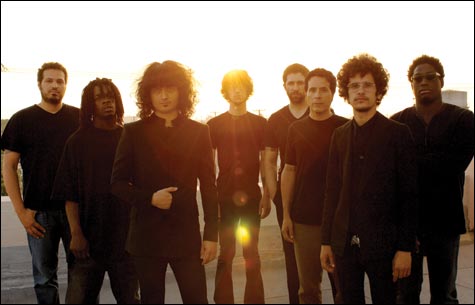
NO PRISONERS! The Mars Volta have been pursuing Hendrix-and-Coltrane nirvana, sales be damned. |
John Coltrane acid blasts rage through the Mars Volta’s new The Bedlam in Goliath (Universal). Or maybe they’re Jimi Hendrix technicolor explosions — the latest emanations of a sonic zeitgeist that Hendrix named the “electric church.”
Either way, the music is a flashback. Not exactly the kind Coltrane might have had after allegedly recording Om (Impulse) on LSD in 1965, but with its thorny compositional sense, impossible-to-follow story line, and blurts of free-form playing, The Bedlam in Goliath is not so far from hallucination.
There’s also something frayed and paisley about Louis XIV’s new Slick Dogs and Ponies (Pineapple/Atlantic). It starts with the sound of a tape recording being played backward, and if you follow that aural trick in the same direction, you come to 1967, the year that Hendrix’s Are You Experienced? (Experience Hendrix) and the Beatles’ Sgt. Pepper’s Lonely Hearts Club Band (Capitol) brought that studio maneuver to the public. Then fast-forward to, say, 1975 and you reach the Electric Light Orchestra’s Face the Music (Sony), whose first track, “Fire on High,” starts with a backwards recording of a voice. Before the days of CDs and downloads, it could be decoded by applying a phonograph needle and spinning the vinyl platter in reverse. That revealed bandleader Jeff Lynne intoning, “The music is reversible, but time is not. Turn back. Turn back. Turn back.”
Today, a new generation of musicians is, indeed, reversing music. Modern rock radio often sounds like a time line snapped by its tail. Death Cab for Cutie and Badly Drawn Boy have hits that could have been plucked from the folk-rock scene of the ’60s and early ’70s. Jet and the Hives buzz as if they were part of the ’80s garage-rock revival, or even the initial wave when the Sonics and the Electric Prunes buzz-sawed into ’60s rock-and-roll history. Then there’s Lenny Kravitz, who could single-handedly put every tribute band out of business.
One reason so many current rock artists are emulating the sounds of the past is that the very best rockers of bygone times broke ground on territory still fertile for exploration. Especially Hendrix and, given the width of his influence, Coltrane, whose sonic expressionism tripped open all kinds of avenues to the id and to the universe. Another reason is that the great musicians of yesterday are still very much a part of today’s cultural landscape, even more than film directors and visual artists. Thanks to the glut of CD reissues and the quick and cheap availability of song downloads, listeners — musicians or civilians — can sample almost any artist of significance who catches their interest.
Bob Marley, Hendrix, the Beatles, and Led Zeppelin all sell more music annually than most current acts, even though they haven’t made a new recording in decades. Hell, so do Lynyrd Skynyrd. It doesn’t help that today’s strictly formatted radio industry affords fewer opportunities to air new bands. But informed young music fans — the kind who will remain passionate about what they listen to as they grow older — stopped caring about most radio years ago. Even before podcasts came onto the radar. They’ve learned they need to find good music themselves. And they do — which is why most of the people wearing T-shirts with images of performers like Hendrix and Marley weren’t even born when those artists died or laid down their torches.